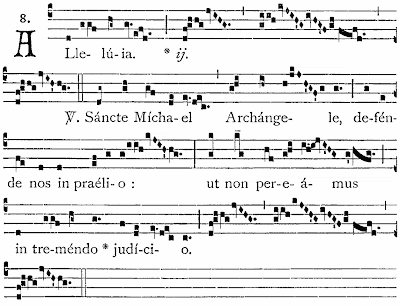According to the Benedictines of Brazil, Laudate Deum, omnes angelus - the Alleluia for the Second Sunday after the Epiphany - can be used as an alternate to Sancte Michael archangele
as the Alleluia for the September 29 Feast of St. Michael and All
Angels (AKA "Ss. Michaelis, Gabrielis et Raphaelis, Archangelorum").
I could not find a recording of Sancte Michael archangele - so here's Laudate Deum, omnes angelus, which is very pretty indeed. (Again, though: I am quite amazed at the cottage industry of St. Michael Archangel videos - all highly dramatic, and often using some of the most surprising music as background! - at YouTube. It seems that the "soldier of God's armies" image really appeals to some people.)
The text comes from Psalm 148, verse 2:
You can listen to recordings of the Introit, Offertory, and Communio at Ss. Michaelis, Gabrielis et Raphaelis, Archangelorum (St. Michael and All Angels, that is): September 29. Listen to the Office Hymns atSeptember 29: The Feast of St. Michael and All Angels.
Other posts for this feast day are collected here.
The Collect for St. Michael and All Angels is a nice one:
Marion Hatchett, in his Commentary on the American Prayer Book, says about this feast that:
I could not find a recording of Sancte Michael archangele - so here's Laudate Deum, omnes angelus, which is very pretty indeed. (Again, though: I am quite amazed at the cottage industry of St. Michael Archangel videos - all highly dramatic, and often using some of the most surprising music as background! - at YouTube. It seems that the "soldier of God's armies" image really appeals to some people.)
The text comes from Psalm 148, verse 2:
Laudate Deum, omnes Angeli eius: laudate eum, omnes virtutes eius. Alleluia.
Praise God, all His Angels, praise Him, all His hosts. Alleluia.
You can listen to recordings of the Introit, Offertory, and Communio at Ss. Michaelis, Gabrielis et Raphaelis, Archangelorum (St. Michael and All Angels, that is): September 29. Listen to the Office Hymns atSeptember 29: The Feast of St. Michael and All Angels.
Other posts for this feast day are collected here.
The Collect for St. Michael and All Angels is a nice one:
Everlasting God, you have ordained and constituted in a wonderful order the ministries of angels and mortals: Mercifully grant that, as your holy angels always serve and worship you in heaven, so by your appointment they may help and defend us here on earth; through Jesus Christ our Lord, who lives and reigns with you and the Holy Spirit, one God, for ever and ever. Amen.
Marion Hatchett, in his Commentary on the American Prayer Book, says about this feast that:
The observance of a day to honor Saint Michael dates to the fifth century when a church near Rome was dedicated to the archangel. The Leonine sacramentary contains a proper for St. Michael's Day (nos. 844-859). In the Eastern churches other angels have been so honored, but the feasts of Gabriel and Raphael did not enter the ROman calendar until this century.
In the 1549 Book the title was expanded to include all angels. Michael is mentioned in Jude 9 and Rev. 12:7 (see also Dan. 10:13, 21, and 12:1). On the basis of these passages he has been honored as the "captain of the heavenly hosts." Gabriel was the messenger of God at the annunciation to Zechariah (Lk. 1:19) and to Mary (Lk. 1:26). He is also mentioned in Dan. 8:16 and 9:21. Raphael is named in the Old Testament Apocrypha (Tobit 3:16-17 and 5:5 ff.). The word "angel" literally means "messenger."
Just for interest, this appears to be a composition by one Rafał Krzychowiec based on the text of other Alleluia for today, Sancte Michael archangele (gregorian chant score below the vid). Interestingly, this piece has spoken parts; I don't know what's being said, though.
I'm not sure which came first, but this text has often been used as an antiphon in various offices in addition to its use here as an Alleluia for the mass:
Sancte Michael archangele defende nos in proelio ut non pereamus in tremendo judicio.
Saint Michael Archangel, defend us in battle so that we may not perish in the awful day of judgment.
Wikipedia has more about a longer "Prayer of St. Michael," and notes that:
This prayer, whose opening words are similar to the Alleluia verse for Saint Michael’s feasts on 8 May and 29 September in the Roman Missal of the time (which ran, "Sancte Michael, defende nos in proelio ut non pereamus in tremendo iudicio"), was added in 1886 to the Leonine Prayers that in 1884 Pope Leo XIII ordered to be said after Low Mass, for the intention of obtaining a satisfactory solution to the problem that the loss of the Pope's temporal sovereignty caused in depriving him of the evident independence required for effective use of his spiritual authority.
Here's a lovely piece of Byzantine art with Michael as subject; the page says it's an "Ivory panel from a Byzantine diptych. Constantinople (AD 525-550)," now in the British Museum.
More from the Wikpedia page:
Constantinople, 6th century AD
Standing beneath an ornate arch, at the top of a flight of steps, the archangel holds an orb and a staff. The Greek inscription, which would have continued on the other leaf read: Receive the suppliant before you, despite his sinfulness.
This is the largest surviving Byzantine ivory panel and probably represents an imperial commission originating from Constantinople. It has been suggested that the angel was presenting the orb to an emperor, perhaps Justinian I (527-565 AD), who was depicted on the other lost leaf.
Height: 42.8 cm (16.9 in) Width: 14.3 cm (5.6 in) Depth: 0.9 cm (0.35 in)



No comments:
Post a Comment